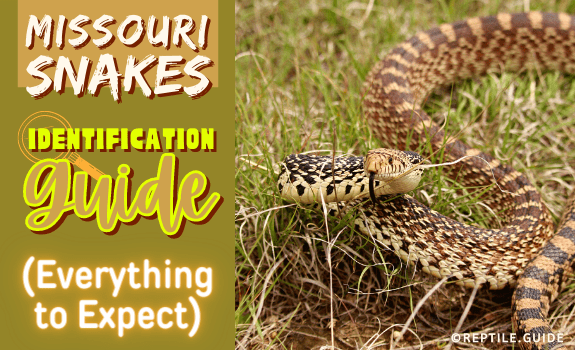Snakes are deeply misunderstood creatures with a bad reputation.
They’re a crucial part of our ecosystem and beneficial to have around.
There are 49 species and subspecies of Missouri snakes, most of which are harmless.
Being able to distinguish venomous snakes from harmless ones can help you avoid a potentially dangerous situation.
Let us help you identify the most common snakes of Missouri and hopefully instill an appreciation for them along the way!
In This Article
What You’ll Learn
In this guide, you’ll find:
- How to quickly identify venomous snakes
- An organized list of every species of snake in Missouri
- How to coexist with snakes and why they’re beneficial
- Resources for snake removal, venomous bites, and additional information
- Individual species profiles on common Missouri snakes with pictures and facts
Missouri Snake Identification Basics
Identifying snakes can be complicated.
Snake appearances often vary based on geographic location.
Some populations can look vastly different from the next within the same species!
This guide is only for snakes in Missouri.
Quickly Identifying Venomous Snakes in Missouri
There are five species of venomous snakes in Missouri.
Fortunately, they all belong to the same family and have relatively distinct features.
However, many snakes have evolved to look or act like venomous snakes to protect themselves.
It can be confusing for those with little experience identifying snakes.
Always proceed with caution if you have doubts about a snake’s identity.
Let’s discuss the best ways of identifying venomous snakes and look at each one native to Missouri.
All Venomous Snakes in Missouri Are Pit Vipers
All five species of Missouri’s venomous snakes are pit vipers.
The pit viper family is a group of venomous snakes sharing several defining characteristics.
Pit vipers have:
- Sensory Pits – There are small heat-sensing pits located between each eye and nostril.
- Hollow Fangs – They deliver venom through their long, hollow fangs. They’re hinged fangs that fold into the top of their mouths when not in use.
- Elliptical Pupils – Their pupils are slit-shaped. Nonvenomous species have round pupils.
- A Single Row of Scales – They have one row of scales on the underside of the end of their tails, called subcaudal scales. Nonvenomous snakes have two rows of scales after their anal plate.
- Triangle-shaped Heads – Venom glands widen the sides of the head, making it appear broad and triangle-shaped. The neck is more narrow than the head.
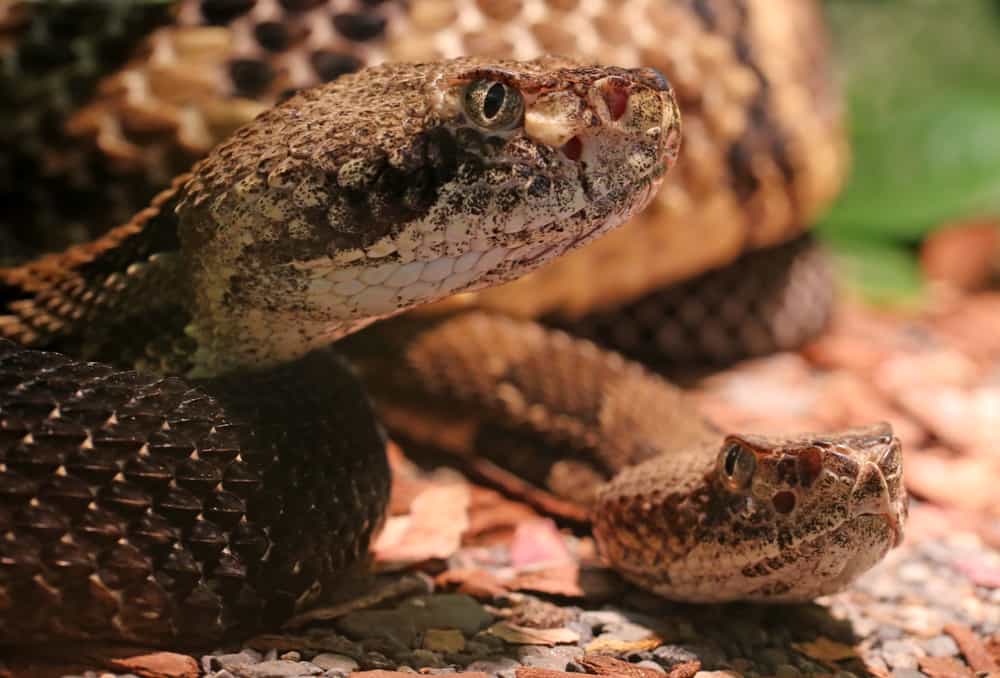
Rattlesnakes typically have unmistakable segmented rattles at the end of their tails in addition to these characteristics.
These traits are beneficial for identifying venomous species but can be misleading to the untrained eye.
A venomous snake’s elliptical pupils can appear round when dilated.
Several harmless snakes widen their head and neck when they feel threatened, making the shape appear similar to pit vipers.
Many snakes imitate a rattlesnake’s notorious rattle by quickly vibrating their tails in brush to ward off predators. The sound alone can be deceptive without a proper look at the tail.
It’s also possible for a rattlesnake’s rattle to break off.
Northern Cottonmouth
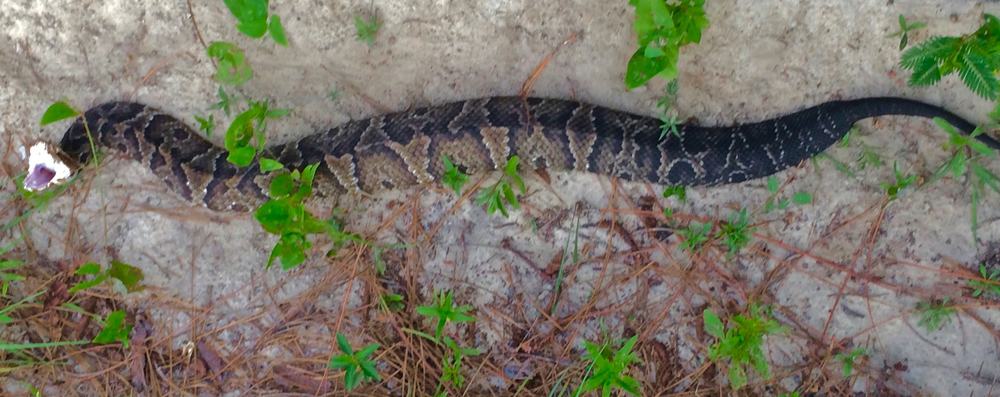
|
Scientific name: |
Agkistrodon piscivorus |
|
Range: |
South of the Missouri River. Mostly in the Southeastern corner and in patches throughout the Ozarks |
|
Size: |
30-42 in. |
|
Description: |
Heavy-bodied Elliptical Pupils Mouth has a white interior lining Blocky head wider than the neck Black or dark brown. Can have dark crossbands along the back |
|
Habitat: |
Aquatic habitats such as swamps, lakes, creeks, and river channels |
|
Diet: |
Fish, frogs, lizards, rodents, and other snakes |
|
Venomous/Non-Venomous: |
Venomous |
A cottonmouth’s pattern fades as it ages. Older adults can appear completely black.
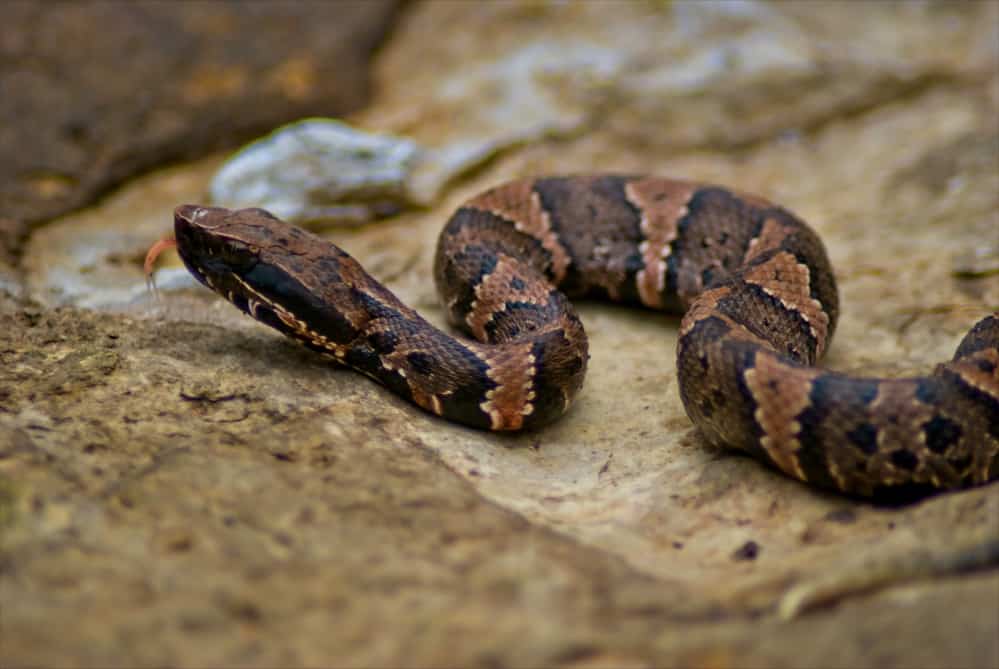
They’re highly venomous, and their bites can be fatal.
Several harmless species are often misidentified as cottonmouths, particularly Missouri water snakes.
Water snakes are discernible by their narrow heads, lack of sensory pits, round pupils, and stripped upper lips.
Eastern Copperhead
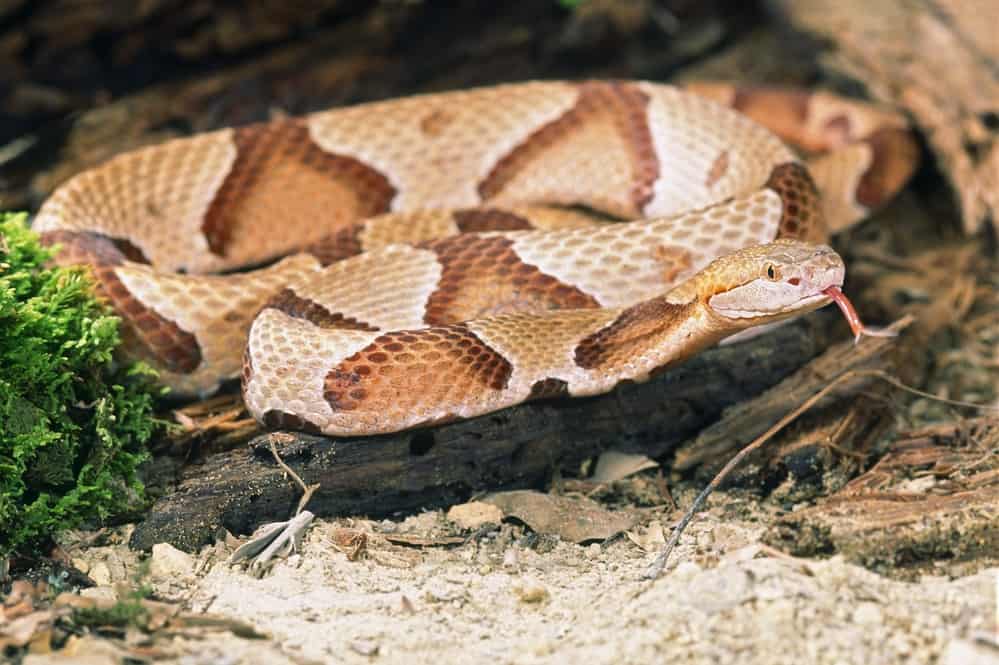
|
Scientific name: |
Agkistrodon contortrix |
|
Range: |
Statewide. Two subspecies in the state: the Osage copperhead (A. c. phaeogaster) in the northern two-thirds of the state, and the southern copperhead (A. c. contortrix) in the southern third |
|
Size: |
24-36 in. |
|
Description: |
Elliptical Pupils Grayish-brown to pinkish-tan Hour-glass-shaped cross-bands May have a pink or orange head Juveniles have yellowish-green tipped tails |
|
Habitat: |
Rocky hillsides and along forest edges and prairie streams |
|
Diet: |
Mice, birds, frogs, lizards, insects, and occasionally small snakes |
|
Venomous/Non-Venomous: |
Venomous |
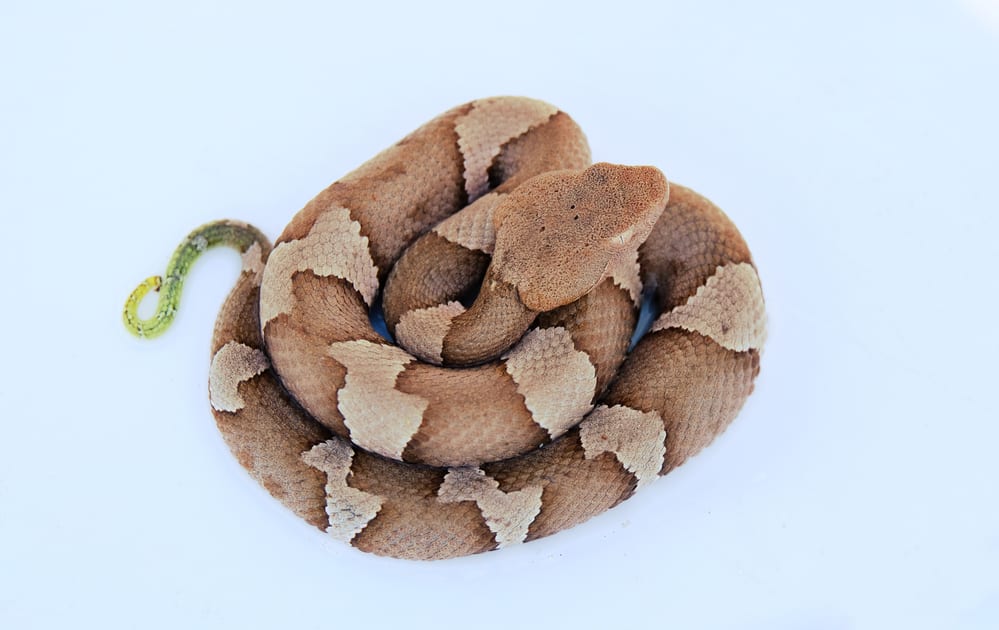
The copperhead is the most common venomous snake in Missouri.
Although it has a mild venom, its bite still requires medical care.
Timber Rattlesnake
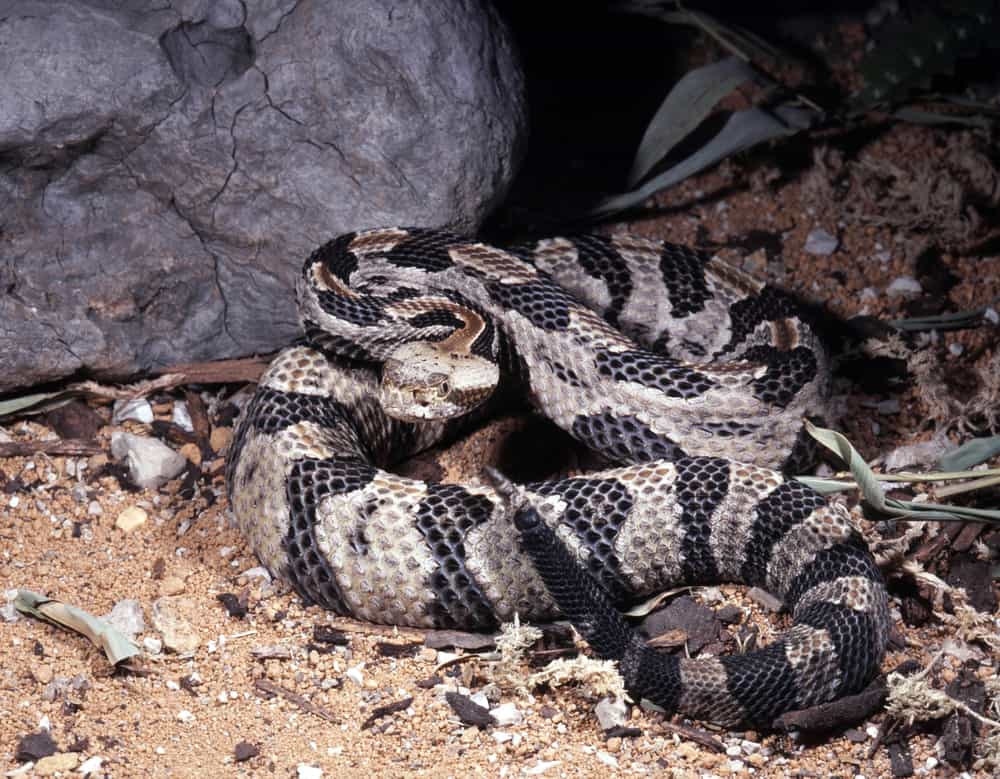
|
Scientific name: |
Crotalus horridus |
|
Range: |
Statewide. |
|
Size: |
36-60 in. |
|
Description: |
Elliptical Pupils Dark line from the eye to the jaw Tan or yellowish-tan with dark brown v-shaped markings and a rust-colored dorsal line |
|
Habitat: |
Woodlands and rocky hillsides |
|
Diet: |
Rodents and rabbits |
|
Venomous/Non-Venomous: |
Venomous |
The timber rattlesnake is the most widespread rattlesnake in the state. Because it prefers rough terrain, people rarely encounter it.
Its venom is highly dangerous, and bites can be fatal if untreated.
Massasauga Rattlesnakes
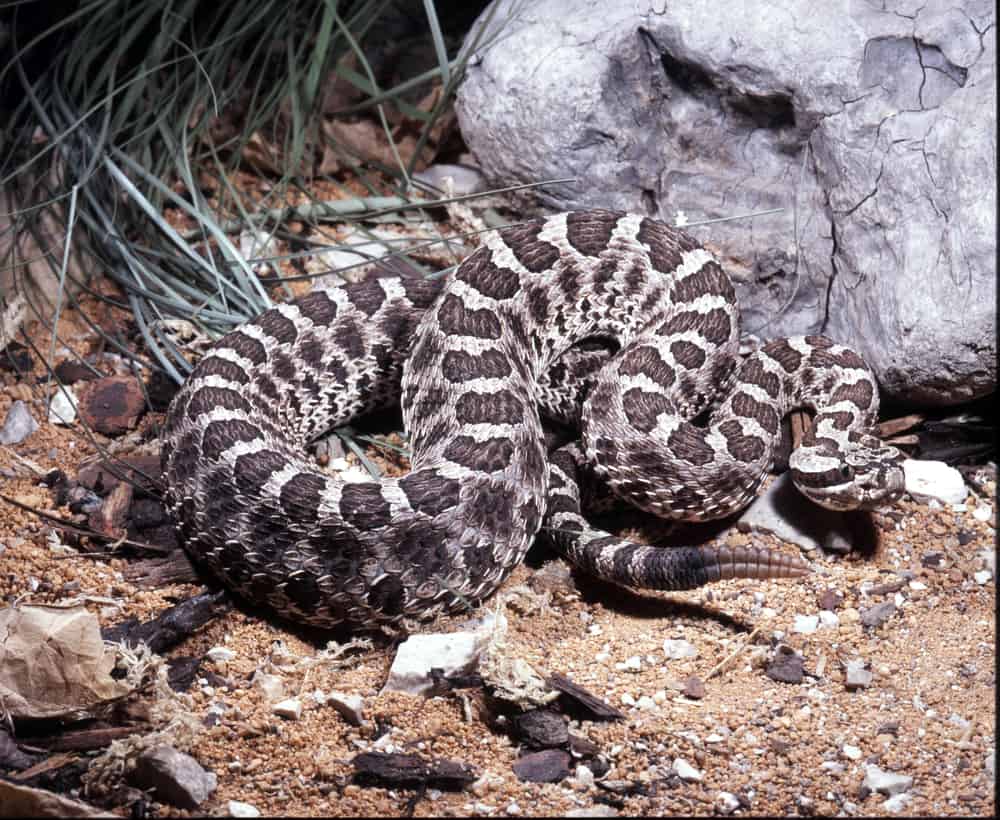
|
Scientific name: |
Eastern Massasauga Rattlesnake Sistrurus catenatus Western Massasauga Rattlesnake Sistrurus tergeminus |
|
Range: |
The Eastern Massasauga (Sistrurus catenatus) used to be along the Mississippi River floodplain north of St. Louis The Prairie Massasauga (S. tergeminus tergeminus), a subspecies of Western Massasauga, is patchy through northwest and north-central Missouri |
|
Size: |
18-30 in. |
|
Description: |
Elliptical Pupils Short, stocky body Gray or black ventral scales Dark line from the eye to the side of the neck Gray or dark gray. Brown or gray blotches cover the body |
|
Habitat: |
Marshes, bottomlands, and wet prairies |
|
Diet: |
Rodents, lizards, and small snakes |
|
Venomous/Non-Venomous: |
Venomous |
Both snakes used to be subspecies of the Eastern massasauga but are now two separate species.
Because of habitat destruction, they’re both endangered in the state.
The eastern massasauga is a candidate for federal endangered species status and may no longer be in Missouri.
They’re highly toxic but rarely encountered in the state.
Western Pygmy Rattlesnake
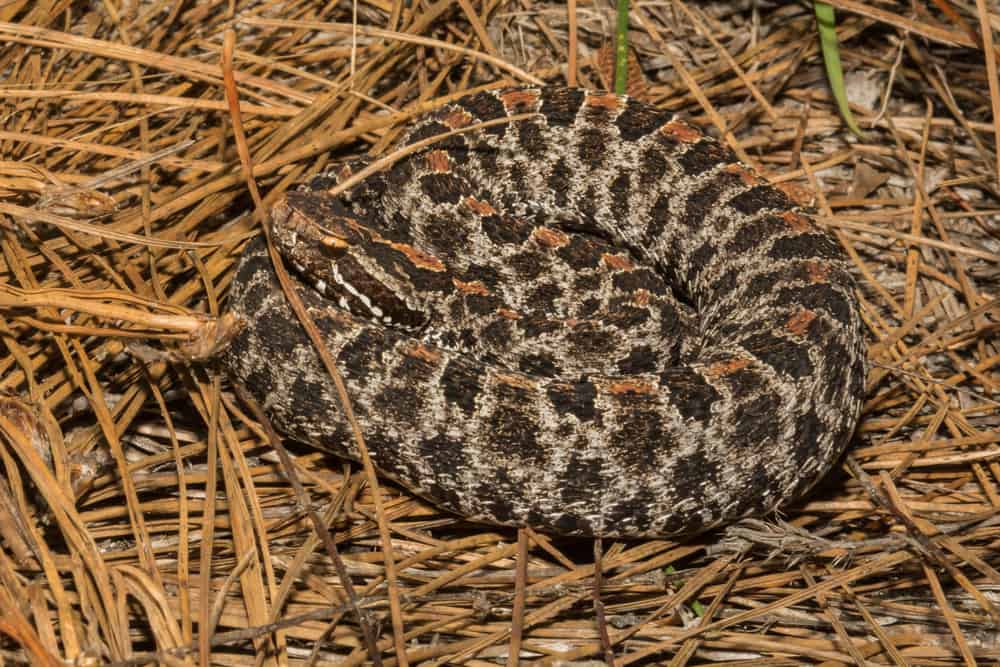
|
Scientific name: |
Sistrurus miliarius streckeri |
|
Range: |
Southern Missouri, bordering Arkansas and the eastern Ozarks |
|
Size: |
15-20 in. |
|
Description: |
Elliptical Pupils Thin tail, small rattle Gray or cream-colored ventral scales Black stripe from the eye to the corner of its mouth Light grayish-brown. Small, dark brown spots along the body with a rust-colored dorsal stripe |
|
Habitat: |
Rocky, wooded hillsides, along forests and meadows, near glades |
|
Diet: |
Mice, lizards, small snakes, and sometimes frogs and insects |
|
Venomous/Non-Venomous: |
Venomous |
The western pygmy rattlesnake has a small rattle that sounds like a quiet buzz. It’s comparable to the sound of a grasshopper.
Most Common Missouri Snakes
Some of the most common snakes in Missouri include:
- Bullsnakes
- Black Rat Snakes
- Prairie Kingsnakes
- Rough Green Snakes
- Timber Rattlesnakes
- Eastern Copperheads
- Eastern Garter Snakes
- Western Worm Snakes
- Midland Brown Snakes
- Northern Water Snakes
- Eastern Hognose Snakes
- Prairie Ring-necked Snakes
- Eastern Yellow-Bellied Racers
Harmless Snakes
Most of the snakes in Missouri are non-venomous and harmless to humans.
Bullsnake
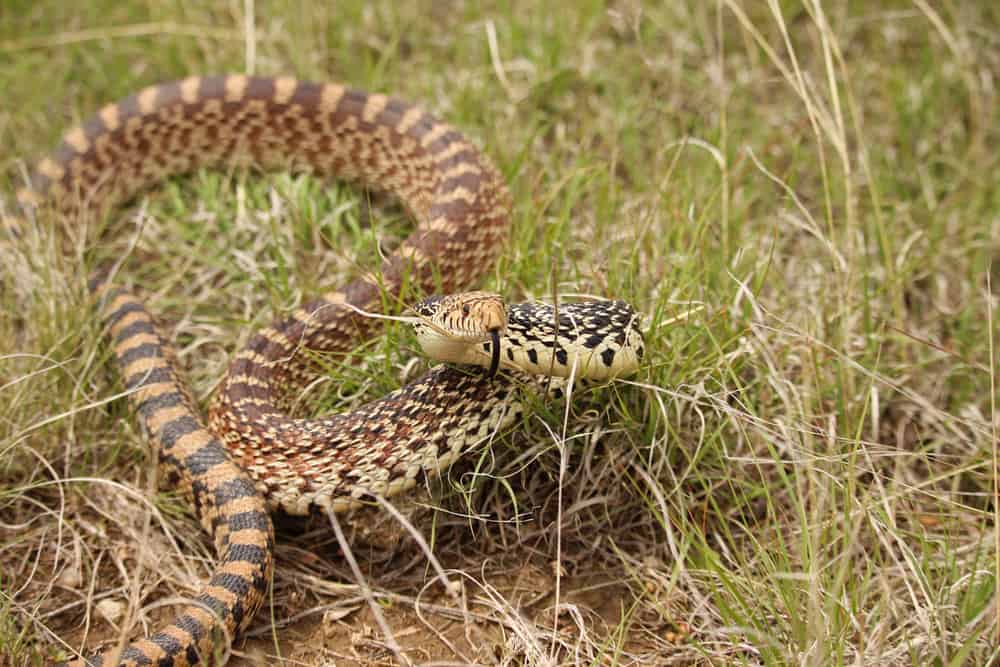
|
Scientific name: |
Pituophis catenifer sayi The bullsnake is a subspecies of gopher snake. |
|
Range: |
Statewide, except for the southeastern third |
|
Size: |
37-72 in. |
|
Description: |
Round pupils Dark line angled from the eye to the jaw Tan, yellow, or cream-colored. Black and brown blotches along the back and sides Ventral scales are yellow or cream-colored, with dark spots checkered along the sides |
|
Habitat: |
Prairies, pastures, fields, and savannas |
|
Diet: |
Rodents and other small mammals, birds, and bird’s eggs |
|
Venomous/Non-Venomous: |
Non-venomous |
The bullsnake is a species of conservation concern in Missouri.
This means it isn’t considered threatened or endangered yet, but there are concerns about its long-term existence.
While you won’t see bullsnakes as often as some of the other species on our list, they’re one of Missouri’s most iconic snakes.
Western Rat Snake
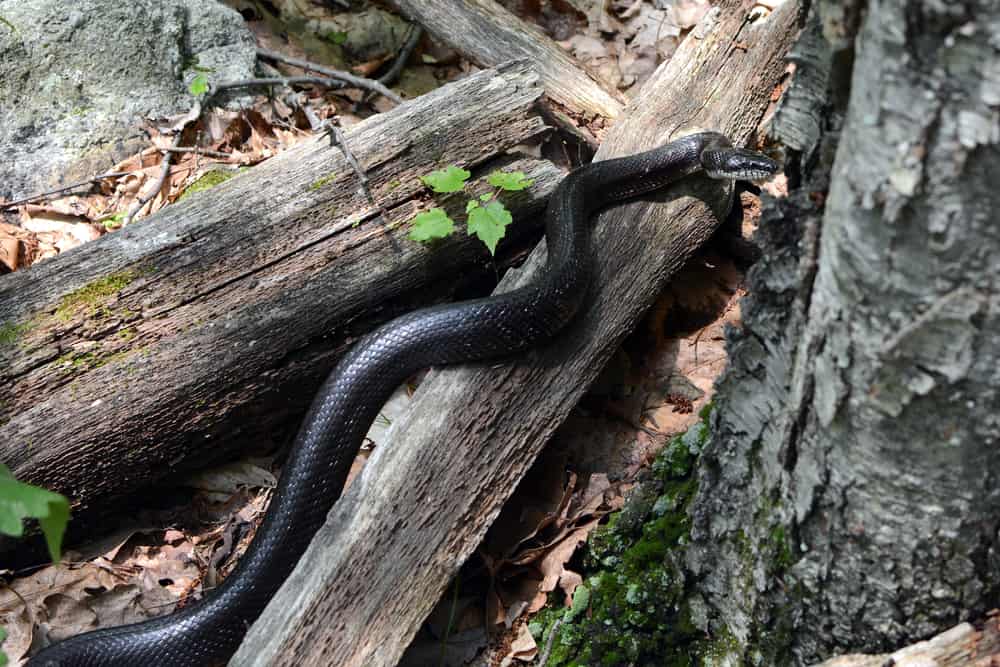
|
Scientific name: |
Pantherophis obsoletus |
|
Range: |
Statewide |
|
Size: |
42-72 in. |
|
Description: |
Round pupils Shiny black scales White chin and upper lip Juveniles are gray or tan with black or dark brown blotches |
|
Habitat: |
A variety of habitats, including rocky hillsides and woodlands near rivers and streams |
|
Diet: |
Mice, rabbits, bats, birds, bird’s eggs, occasionally lizards |
|
Venomous/Non-Venomous: |
Non-venomous |
These common black snakes in Missouri go by many names:
- Black snake
- Black rat snake
- Texas rat snake
Prairie Kingsnake
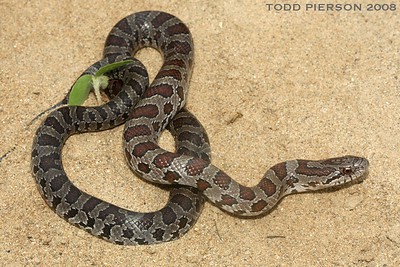
Image credit: Todd Pierson (via CreativeCommons.org)
|
Scientific name: |
Lampropeltis calligaster calligaster |
|
Range: |
Statewide |
|
Size: |
30-42 in. |
|
Description: |
Round pupils Smooth scales V or U-shape on top of the head Yellow or tan ventral scales with brown markings Tan, brownish or greenish-gray. Dark red or greenish-brown blotches |
|
Habitat: |
Prairies, woodlands, and rocky hillsides |
|
Diet: |
Rodents, lizards, other snakes (including venomous ones), and sometimes birds |
|
Venomous/Non-Venomous: |
Non-venomous |
Many people misidentify juvenile prairie kingsnakes as copperheads. They have round or square-shaped markings along their backs instead of hourglass shapes like a copperhead.
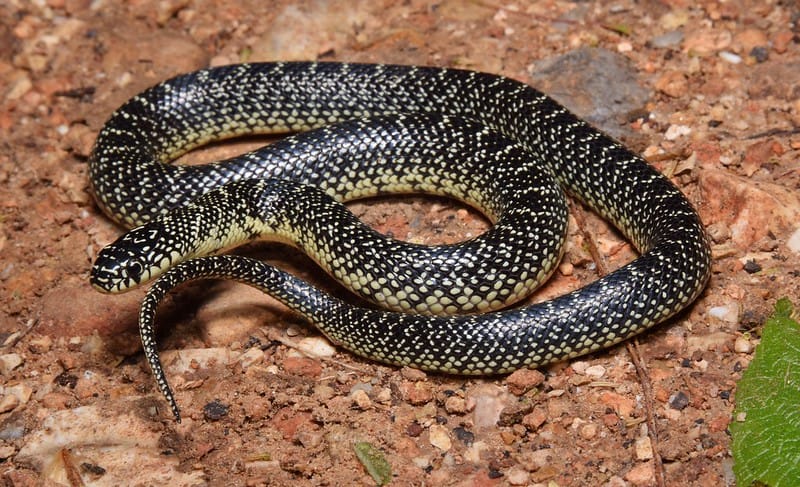
Image credit: smashtonlee05 (via CreativeCommons.org)
The speckled kingsnake (Lampropeltis holbrooki) is another species of kingsnake regularly found throughout Missouri.
Rough Green Snake
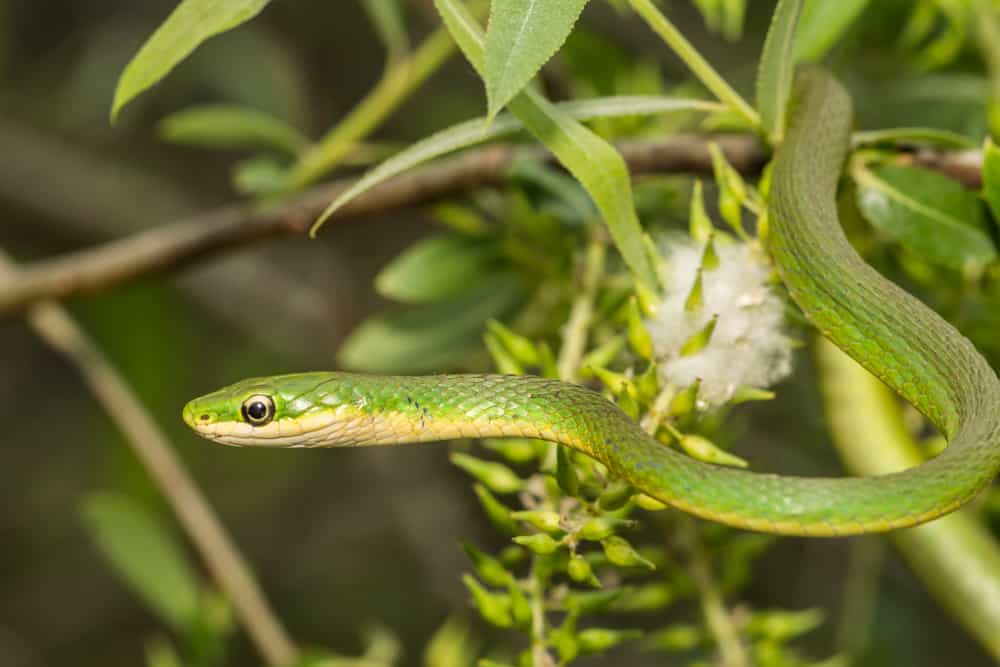
|
Scientific name: |
Opheodrys aestivus |
|
Range: |
Southern two-thirds of Missouri |
|
Size: |
22-32 in. |
|
Description: |
Round pupils Slender body Keeled scales Uniformly light green White or yellow ventral scales |
|
Habitat: |
In bushes, vines, and trees near streams and lakes |
|
Diet: |
Spiders and soft insects (crickets, caterpillars, grasshoppers, etc.) |
|
Venomous/Non-Venomous: |
Non-venomous |
Eastern Garter Snake
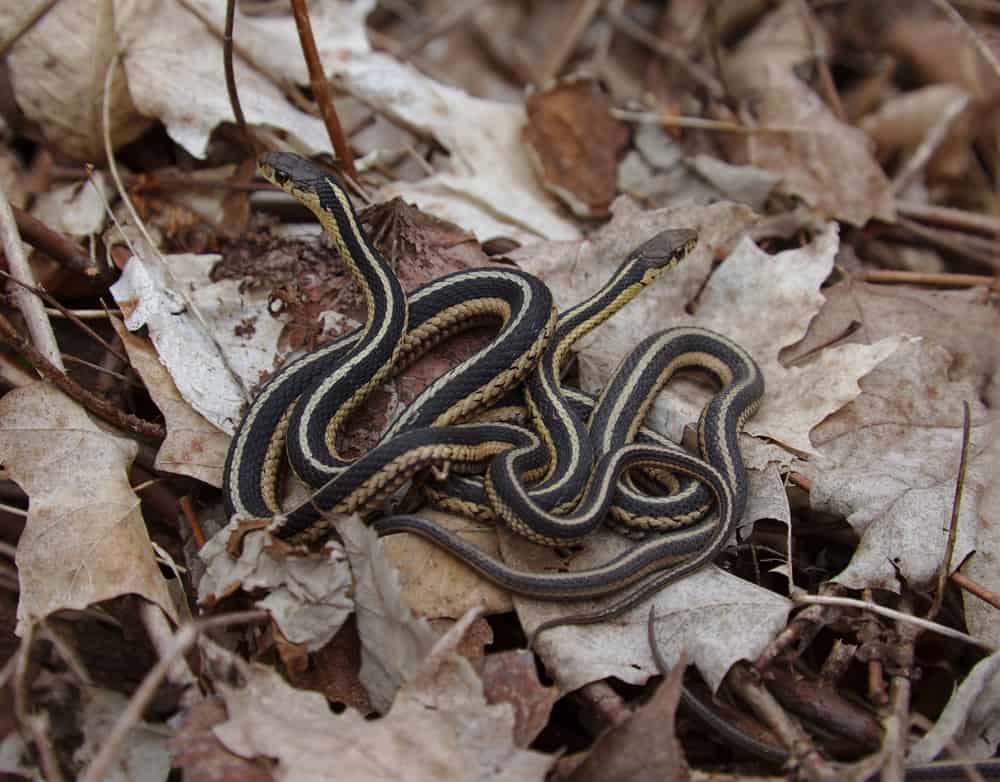
|
Scientific name: |
Thamnophis sirtalis sirtalis |
|
Range: |
Eastern half of Missouri. The red-sided garter snake subspecies (T. sirtalis parietalis) is in the western half |
|
Size: |
18-26 in. |
|
Description: |
Round pupils Black, dark brown, or olive Yellowish-green ventral scales with two rows of black spots Three yellow or tan stripes run down the back and sides. May have spots in the areas between the stripes |
|
Habitat: |
A variety of habitats near water, including woodlands, fields, farmland, and urban areas |
|
Diet: |
Earthworms, frogs and toads, tadpoles, salamanders, and occasionally minnows, mice, and other snakes |
|
Venomous/Non-Venomous: |
Non-venomous |
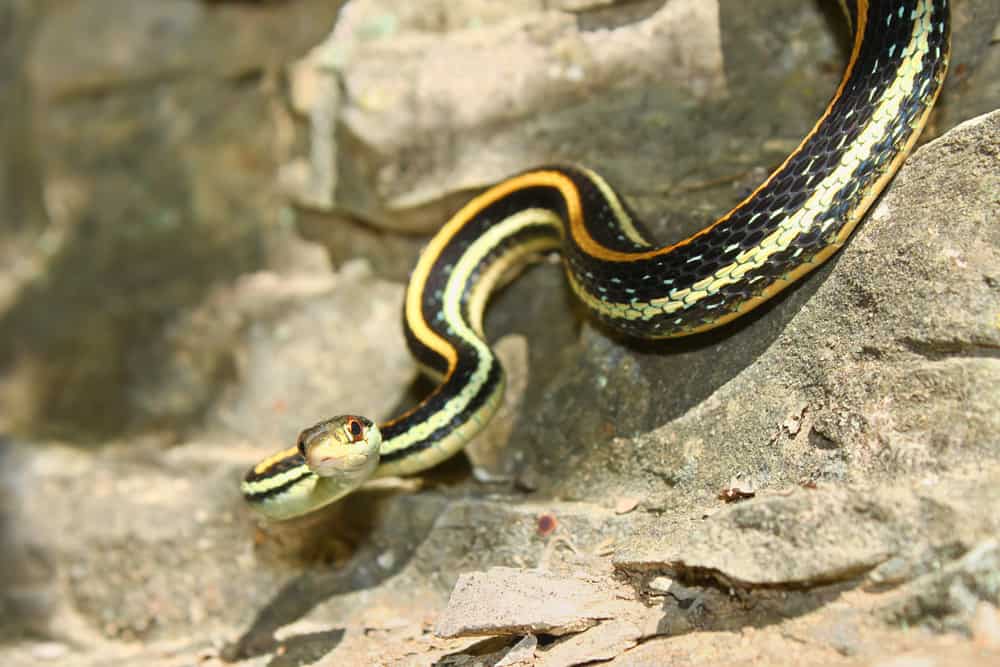
There are three species of garter snake in Missouri. The common garter snake (T. sirtalis), western ribbon snake (T. proximus), and plains garter snake (T. radix).
Midland Brown Snake
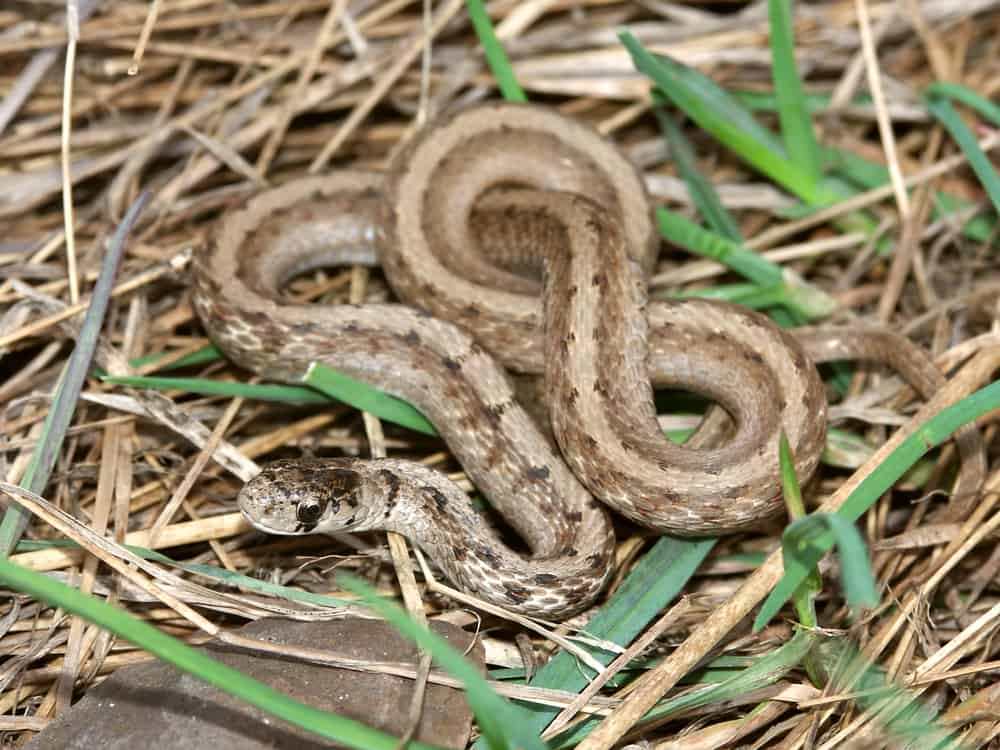
|
Scientific name: |
Storeria dekayi wrightorum |
|
Range: |
Statewide |
|
Size: |
9-13 in. |
|
Description: |
Round pupils Top of head is dark White or yellow ventral scales Gray-brown or reddish-brown Tan dorsal stripe with rows of small, dark spots along the edges. May have bars connecting the spots |
|
Habitat: |
Moist habitats. Near marshes or swamps, in woodlands, floodplains, or rocky hillsides |
|
Diet: |
Earthworms, slugs, snails, soft insects |
|
Venomous/Non-Venomous: |
Non-venomous |
Brown snakes have specialized jaws for holding and consuming snails.
Western Worm Snake
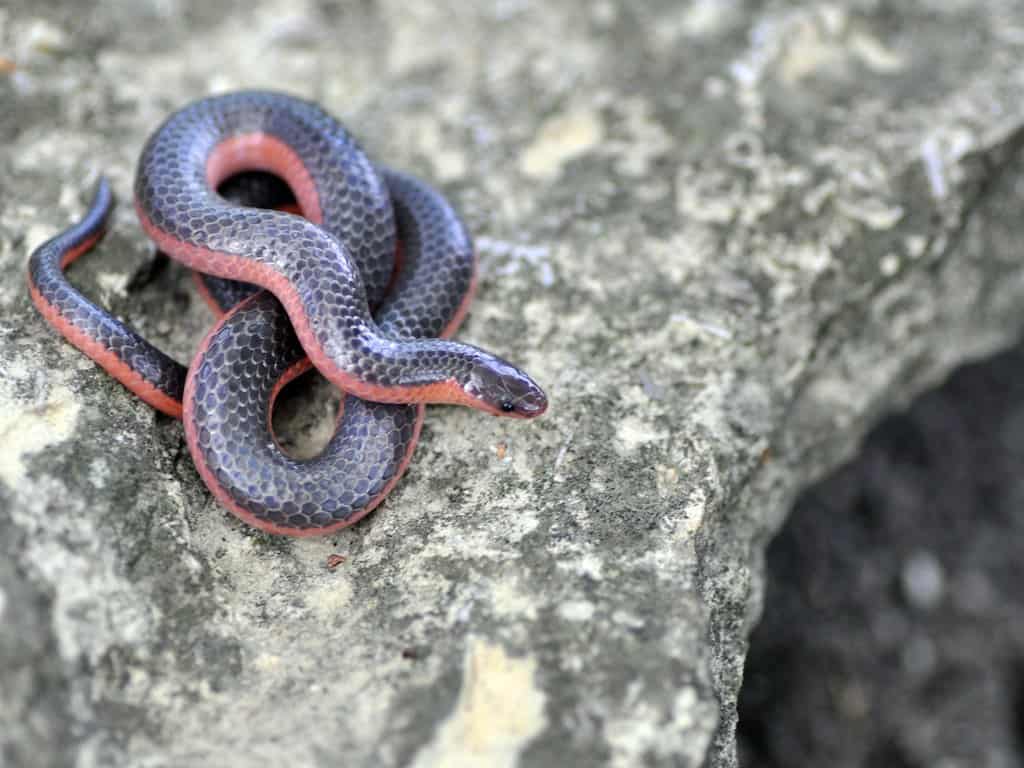
Image credit: smalleraperture (via CreativeCommons.org)
|
Scientific name: |
Carphophis vermis |
|
Range: |
Statewide except for southeastern Missouri and a few north-central areas |
|
Size: |
7-11 in. |
|
Description: |
Round pupils Small head and eyes Spike on end of the tail Dark purple-brown color Pink or salmon-colored ventral scales extend onto the lower sides |
|
Habitat: |
Rocky, wooded hillsides, or forest edges. Always found burrowed in soil or under rocks, logs, leaves, or other natural hides |
|
Diet: |
Earthworms, soft insects, and insect larvae and eggs |
|
Venomous/Non-Venomous: |
Non-venomous |
Because of its preferred habitat, it may take a little effort to find a worm snake. It’s fossorial, meaning it spends most of its time burrowed under soil or leaf litter.
Northern Water Snake
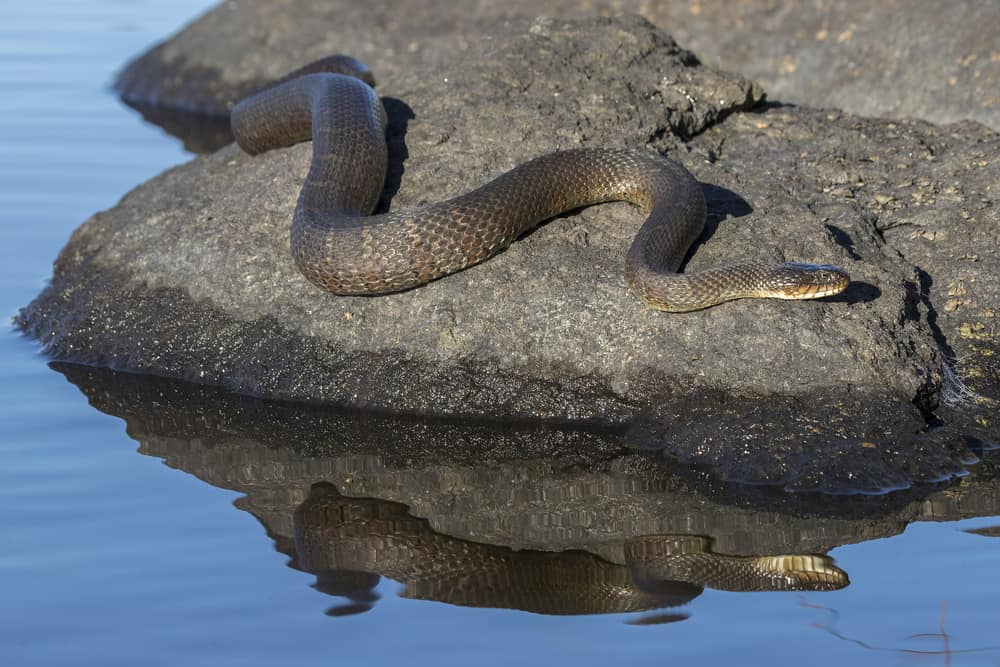
|
Scientific name: |
Nerodia sipedon sipedon |
|
Range: |
Northern two-thirds of Missouri Another subspecies, the midland watersnake (N. sipedon pleuralis), lives in the southern third of the state |
|
Size: |
24-42 in. |
|
Description: |
Round pupils Gray or reddish-brown with dark bands Cream or yellow ventral scales with dark half-moon-shaped markings |
|
Habitat: |
Semiaquatic and live near sources of water, such as ponds, lakes, creeks, rivers, swamps, and marshes |
|
Diet: |
Fish, frogs, toads, tadpoles, and salamanders |
|
Venomous/Non-Venomous: |
Non-venomous |
People often kill the northern water snake when they mistake it for a cottonmouth.
Their bodies are more slender, they have flatter heads the same width as their necks, and they lack sensory pits.
Eastern Hognose Snake
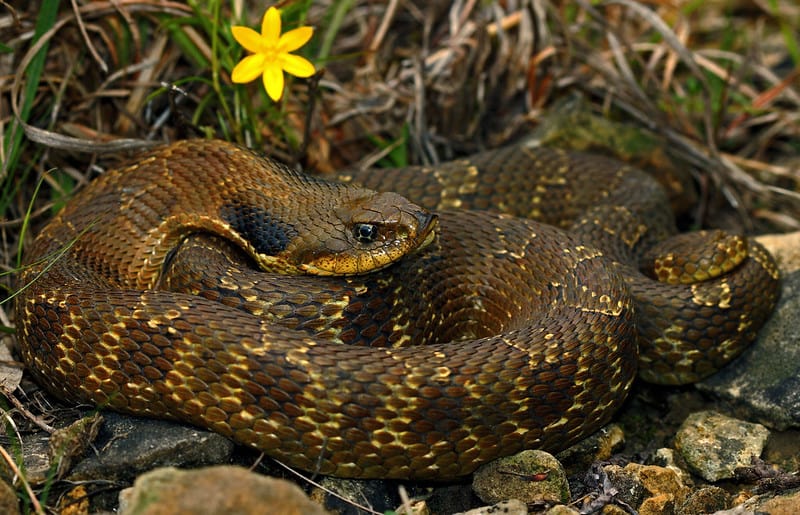
Image credit: 2ndPeter (via CreativeCommons.org)
|
Scientific name: |
Heterodon platirhinos |
|
Range: |
Statewide |
|
Size: |
20-33 in. |
|
Description: |
Round pupils Heavy-bodied Ventral scales speckled with gray Its up-turned snout is its most distinctive characteristic Coloration is variable, but they always have dark blotches behind the head Usually gray-brown or tan, but can be yellow, orange, black, brown, or olive Some have dark blotches along the back, while others have no markings |
|
Habitat: |
Areas with sandy or loose soil |
|
Diet: |
Mainly toads, but also frogs and salamanders |
|
Venomous/Non-Venomous: |
Non-venomous |
Hognose snakes have several well-known defensive mechanisms. These little harmless snakes put on a big display.
When startled, they hiss and spread their necks to appear more threatening.
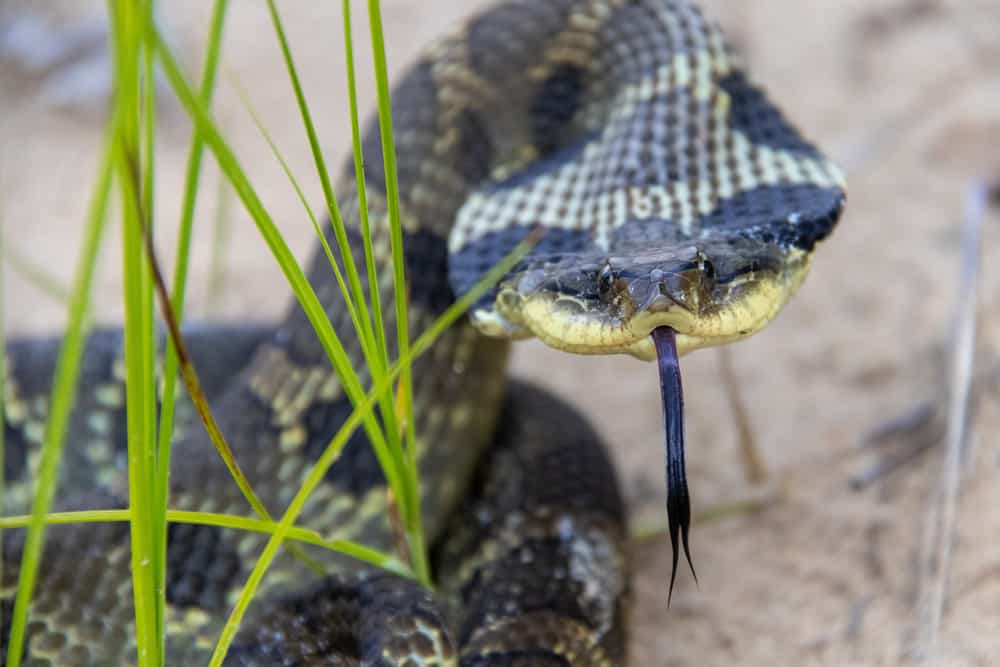
If this isn’t intimidating enough, the hognose will play dead.
It thrashes around, rolls over on its back, opens its mouth, and sticks out its tongue. It can even bleed from the mouth to be more convincing.
Prairie Ring-necked Snake
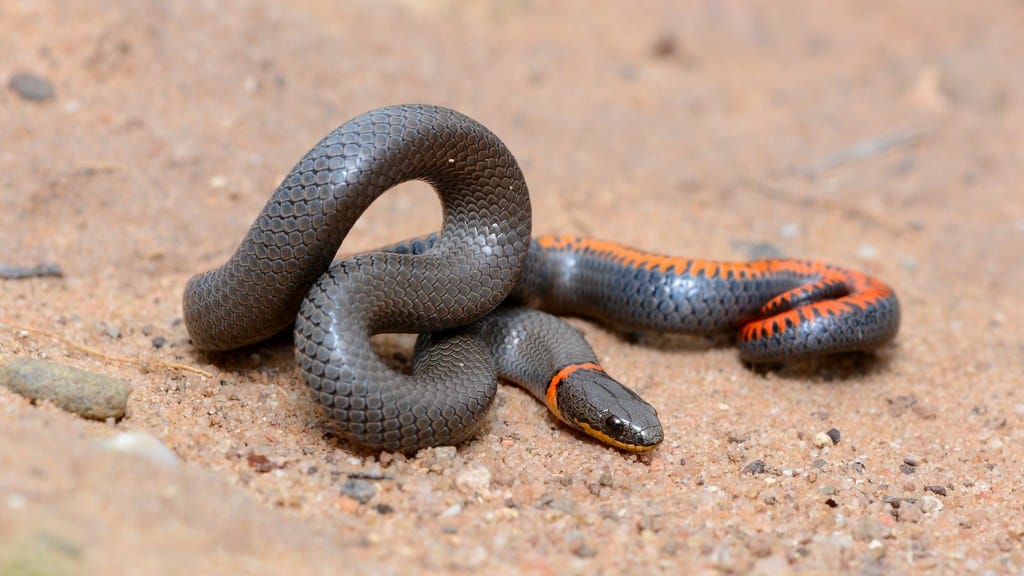
Image credit: amdubois01 (via CreativeCommons.org)
|
Scientific name: |
Diadophis punctatus arnyi |
|
Range: |
Statewide except for the southeastern corner, where the Mississippi ring-necked snake (D. punctatus stictogenys) resides |
|
Size: |
10-14 in. |
|
Description: |
Round pupils Ventral scales are yellow and change to orange towards the tail Patternless dark brown, gray, or black. Distinctive yellow ring around the neck |
|
Habitat: |
Rocky, wooded hillsides, grasslands, rocky glades, and woodland borders |
|
Diet: |
Earthworms, slugs, soft insects, salamanders |
|
Venomous/Non-Venomous: |
Non-venomous |
Eastern Yellow-Bellied Racer
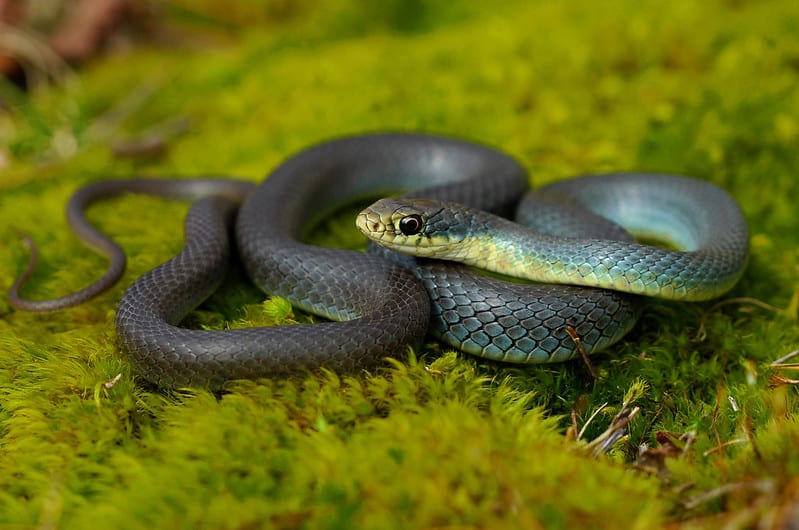
Image credit: 2ndPeter (via CreativeCommons.org)
|
Scientific name: |
Coluber constrictor flaviventris |
|
Range: |
Statewide, except for the southeastern corner where it’s replaced by the southern black racer subspecies (C. constrictor priapus) |
|
Size: |
30-50 in. |
|
Description: |
Round pupils Fast-moving Slender body Smooth scales Yellow, cream, or gray ventral scales Coloration varies from olive, tan, brown, blue, gray, or black |
|
Habitat: |
Grasslands, woodlands, rocky hillsides, and forest edges |
|
Diet: |
Rodents, birds, frogs, lizards, small snakes, and insects |
|
Venomous/Non-Venomous: |
Non-venomous |
Habitat Specialists
Some snakes are habitat generalists and live in all areas of the state. Others are considered habitat specialists and are restricted to specific locations.
These species are usually more rare, but equally as important.
Some of the state’s best examples of habitat specialists include the flat-headed snake and western mud snake.
Flat-headed Snake
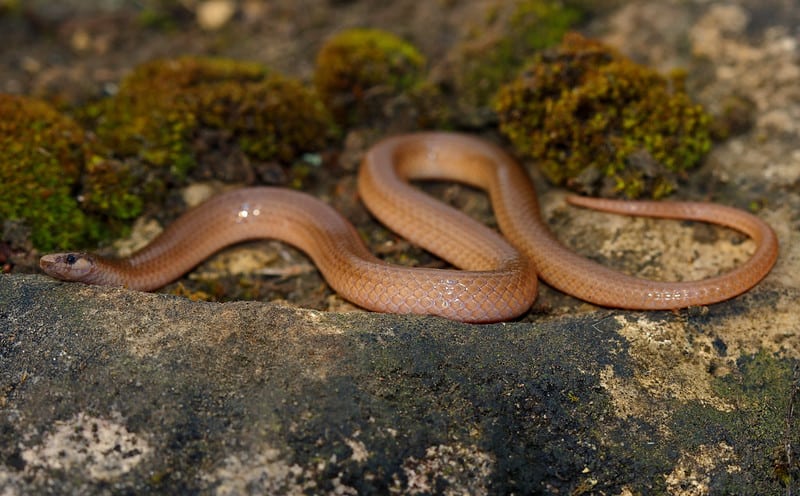
Image credit: 2ndPeter (via CreativeCommons.org)
|
Scientific Name: |
Tantilla gracilis |
|
Range: |
Southern half of Missouri |
|
Size: |
7-8 in. |
|
Description: |
Round pupils Smooth scales Pink ventral scales Tan, gray-brown, or reddish-brown |
|
Habitat: |
Rocky, wooded hillsides with sandy soil and limestone rock. Likes to burrow in moist soil |
|
Diet: |
Centipedes, insects, and insect larvae |
|
Venomous/Non-Venomous |
Non-venomous |
Mud Snake
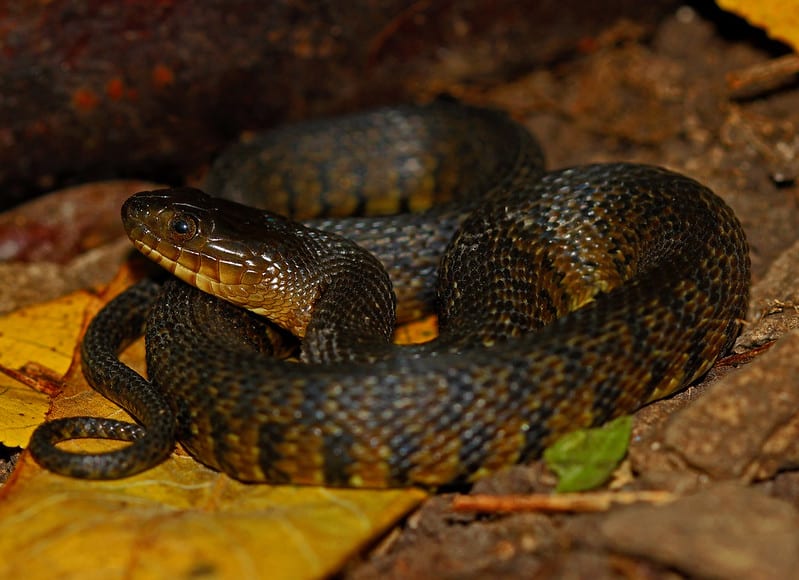
Image credit: 2ndPeter (via CreativeCommons.org)
|
Scientific Name: |
Farancia abacura reinwardtii |
|
Range: |
Southeast corner of the state |
|
Size: |
40-54 in. |
|
Description: |
Round Pupils Point on the end of the tail Iridescent, glossy black scales Red, pink, and orange ventral scales with some black markings |
|
Habitat: |
Cypress swamps of the Mississippi lowlands |
|
Diet: |
Specialized diet of eel-like amphibians, and occasionally frogs, tadpoles, and fish |
|
Venomous/Non-Venomous |
Non-venomous |
Snakes Native to Missouri
Below is a list of snake species native to Missouri, organized by family.
Colubridae
|
Racers |
|
|---|---|
|
Eastern Racer |
Coluber constrictor |
|
Fox Snakes |
|
|
Eastern Fox Snake |
Pantherophis vulpinus |
|
Western Fox Snake |
Pantherophis ramspotti |
|
Rat Snakes |
|
|
Western Rat Snake |
Pantherophis obsoletus |
|
Great Plains Rat Snake |
Pantherophis emoryi |
|
Mud Snakes |
|
|
Mud Snake |
Farancia abacura |
|
Kingsnakes |
|
|
Prairie Kingsnake |
Lampropeltis calligaster |
|
Eastern Milksnake |
Lampropeltis triangulum |
|
Speckled Kingsnake |
Lampropeltis holbrooki |
|
Eastern Black Kingsnake |
Lampropeltis nigra |
|
Coachwhips |
|
|
Coachwhip |
Masticophis flagellum |
|
Worm Snakes |
|
|
Western Worm Snake |
Carphophis vermis |
|
Lined Snakes |
|
|
Lined Snake |
Tropidoclonion lineatum |
|
Earth Snakes |
|
|
Rough Earth Snake |
Haldea striatula |
|
Water Snakes |
|
|
Common Watersnake |
Nerodia sipedon |
|
Southern Watersnake |
Nerodia fasciata |
|
Plain-Bellied Watersnake |
Nerodia erythrogaster |
|
Diamond-Backed Watersnake |
Nerodia rhombifer |
|
Mississippi Green Watersnake |
Nerodia cyclopion |
|
Green Snakes |
|
|
Rough Green Snake |
Opheodrys aestivus |
|
Smooth Green Snake |
Opheodrys vernalis |
|
Brown Snakes |
|
|
De Kay’s Brown Snake |
Storeria dekayi |
|
Garter Snakes |
|
|
Plains Gartersnake |
Thamnophis radix |
|
Western Ribbon Snake |
Thamnophis proximus |
|
Common Garter Snake |
Thamnophis sirtalis |
|
Gopher Snakes |
|
|
Gopher Snake |
Pituophis catenifer |
|
Ground Snakes |
|
|
Western Ground Snake |
Sonora semiannulata |
|
Scarlet Snakes |
|
|
Scarlet Snake |
Cemophora coccinea |
|
Crayfish Snakes |
|
|
Graham’s Crayfish Snake |
Regina grahamii |
|
Hognose Snakes |
|
|
Eastern Hognose Snake |
Heterodon platirhinos |
|
Heterodon nasicus |
|
|
Centipede Snakes |
|
|
Flat-headed Snake |
Storeria occipitomaculata |
|
Ring-necked Snakes |
|
|
Ring-necked Snake |
Diadophis punctatus |
Viperidae
|
Rattlesnakes |
|
|
Pygmy Rattlesnake |
Sistrurus miliarius |
|
Timber Rattlesnake |
Crotalus horridus |
|
Massasauga Rattlesnake |
Sistrurus catenatus |
|
American Moccasins |
|
|
Eastern Copperhead |
Agkistrodon contortrix |
|
Northern Cottonmouth |
Agkistrodon piscivorus |
Snake Conservation
The Missouri Department of Conservation lists these species as extirpated or likely extirpated from the state:
- Smooth Green Snake – Opheodrys vernalis
- Plains Hognose Snake – Heterodon nasicus nasicus
- Mississippi Green Water Snake – Nerodia cyclopion
- Eastern Massasauga Rattlesnake – Sistrurus catenatus
Missouri considers a species extirpated or no longer exists after there’s been no documentation of it in the state for many years.
Other species, like the eastern and western fox snake, are listed as critically imperiled and species of conservation concern.
Habitat loss and persecution are the most common reasons for the decline of these species.
Many of Missouri’s wetlands have been drained, prairies converted into agricultural lands, and other natural areas cleared to make room for the expansion of our cities and homes.
Our state and federal governments work to protect and restore these populations, but it’s up to the people to end the senseless killing of snakes.
Smooth Green Snake
The smooth green snake once inhabited the grassy meadows of northern Missouri, but no one has seen it there in decades.
Habitat destruction and insecticides have led to this species’ demise within the state.
Using insecticides can indirectly affect animals like the smooth green snake that rely on insects as a primary food source.
Plains Hognose Snake
The plains hognose snake prefers sandy, loose soil in prairies. It was once present in the northwestern corner of Missouri, but residents and officials haven’t seen it for years.
The dusty hognose snake used to be a subspecies of plains hognose snake, and has recently been rediscovered in the southeast corner of the state.
They’re both listed as species of conservation concern.
Mississippi Green Water Snake
The Mississippi green water snake used to be common in the bootheel of Missouri.
But it is currently listed as endangered in the state and may no longer be present.

Image credit: 2ndPeter via Creativecommons.org
They make their homes in cypress swamps and river sloughs. Habitat destruction has contributed to the significant decline of these snakes in the state.
Eastern Massasauga Rattlesnake
The eastern massasauga rattlesnake is a candidate for federal endangered status and is most likely no longer in the state.
The prairie massasauga rattlesnake was once a subspecies of eastern massasauga. It’s now a subspecies of western massasauga and endangered in Missouri.
What You Need to Know
Snakes don’t consider humans as prey but as big intimidating predators.
Most snake bites occur when the person is attempting to handle, relocate, or harm a snake.
Snakes won’t chase or attack you.
They usually give several warnings before biting.
Both venomous and non-venomous snakes hiss, vibrate their tails, secrete a foul-smelling musk, or make themselves look bigger to ward off predators.
To stay safe, the best thing to do is leave wildlife alone.
Coexisting With Snakes
Some people don’t want snakes near their homes because they fear for their safety and the safety of their loved ones.
There’s no reason to be afraid of snakes.
Sadly, many people don’t consider the many benefits of having snakes around. They play essential roles in maintaining a healthy ecosystem.
Snakes control pest populations and are a source of food for many animals. Mammals, birds, other snakes, and even frogs and fish eat snakes.
They prevent the spread of disease by eating mice and rats.
Water snakes help control fish populations. They eat slow-moving, sick, or injured fish.
Some snakes, like the rough green snake, eat insects and spiders.
Unless you’re in immediate danger, it’s illegal to kill snakes in the state of Missouri. The Wildlife Code of Missouri treats snakes as nongame animals.
If you find snake eggs on your property, the best thing to do is leave them where they are.
Most snakes don’t tend to their eggs. They lay them and move on.
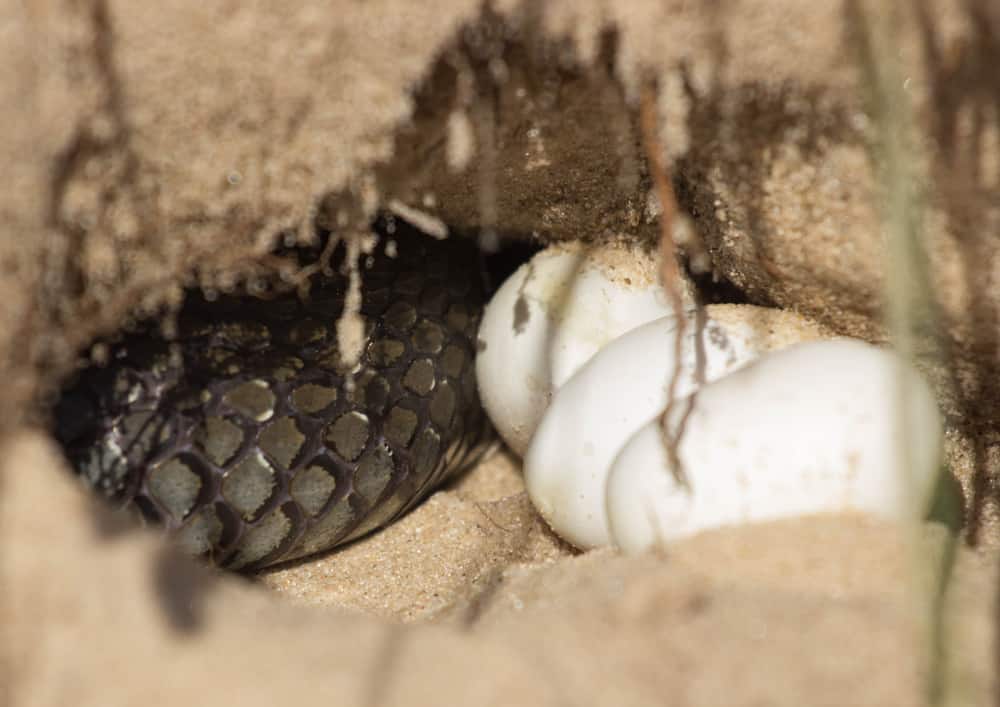
There’s no need to be concerned about the eggs belonging to a venomous snake.
All of the venomous species in Missouri are ovoviviparous, which means they give live birth.
Contact a local wildlife rehabilitation center or animal control if you’re uncomfortable with eggs around your home.
There are several steps you can take to discourage snakes from your property. Eliminate sources of food and shelter by:
- Keeping grass short and shrubs and trees trimmed
- Cleaning up and removing potential food for rodents
- Removing piles of wood, rocks, metal, and general debris
- Sealing holes or gaps in your doors, windows, and foundation that snakes could fit through
Before you have snakes or their eggs removed from your property, ask yourself what you’d rather have… more pesky rodents or a few inconspicuous snakes around?
Snake Safety
Snakes are generally non-aggressive, but accidents happen sometimes.
Keep reading for advice on how to stay safe around wild snakes.
Venomous Snakes
Commonly mislabeled as poisonous snakes in Missouri, venomous snakes produce a toxin that they inject through their fangs. Poison is ingested.
A venomous snake primarily uses its toxin to subdue prey. It uses it in self-defense as a last resort.
Bites typically occur when the snake feels its life is in danger. This is most common when someone tries to handle the snake.
There are an average of 100 venomous snake bites recorded in Missouri every year, and deaths are extremely rare.
Medical advancements and the use of antivenoms have significantly lowered fatalities.
Most fatal bites result from the person not seeking medical care, an uncommon allergic reaction, or other health complications.
Treading Carefully in Snake Habitats
Snakes are most common in Missouri’s prairies, woodlands, near sources of water, and in the hills and valleys of the Ozarks.
If you’re spending time in these areas, there are a few precautions you should take to keep yourself safe.
The most important thing is to watch your step. Snakes like hiding in tall grasses and leaf litter where it’s difficult to see them.
Rather than flee when startled, some snakes are more prone to camouflage themselves with their surroundings.
If you can’t see the ground in front of you, try using a stick to move litter and grass to the side.
Wear tall, sturdy boots that go over your ankle. Long, thick pants can reduce the impact of a snake bite.
If you frequently work in well-known snake habitats, it may be a good idea to invest in pants, boots, or guards specifically made to withstand snake bites.
Be cautious when picking up or turning over logs, sticks, and rocks.
Try not to put your hands anywhere where you can’t see them.
Keep pets on a leash, watch where they put their noses, and stick to well-worn or paved paths to keep them safe.
What to Do if You Encounter a Snake
Seeing these amazing animals in the wild is exciting! They’re typically shy and quickly retreat out of sight.
Some snakes tend to hunker down and attempt to camouflage with their surroundings.
If you come across a snake in the wild, the best thing to do is leave it alone.
It may be startled by your presence and feel trapped. If it doesn’t leave on its own, don’t try moving it.
Snakes are ectotherms, meaning they rely on external heat sources for regulating their body temperature.
On colder days, you’ll find them basking in the sun on rocks or roads for warmth.
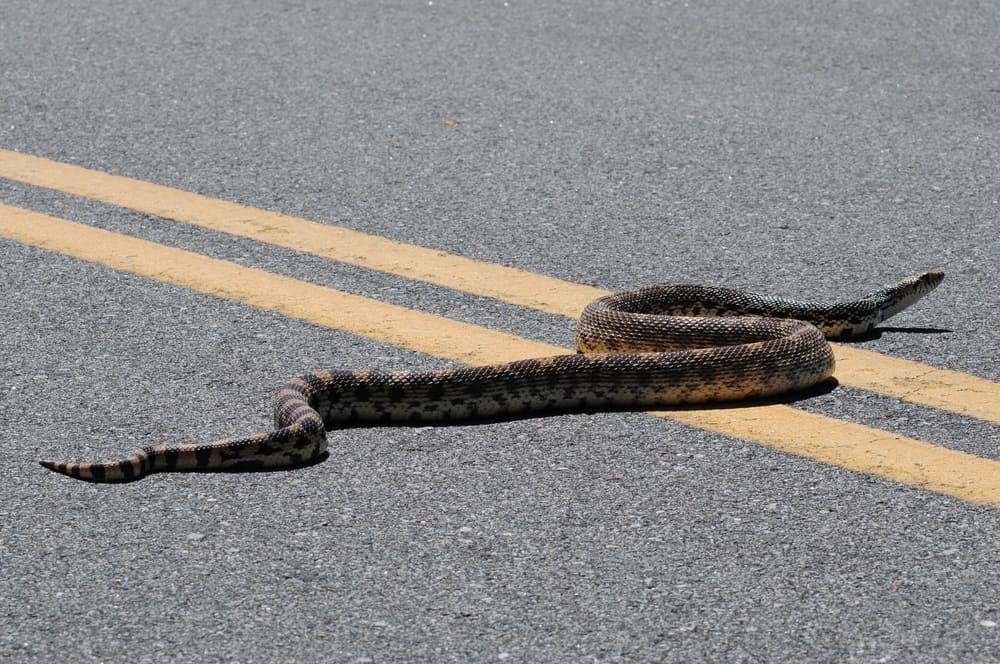
If a snake is cold, it may be sluggish, and it may take them longer to move away.
After you admire it, give the snake some space and find a safe route around if it doesn’t move.
When to Call for Help
The two most important things to do if a venomous snake bites you are to stay calm and call 911 or have someone take you to the nearest emergency room immediately.
Don’t wait for symptoms to appear.
Antivenom is most effective when given as soon as possible and should be administered within four hours.
While you wait for treatment, it’s helpful to:
- Stay as still as possible.
- Try to keep the wound below heart level.
- Wash the bite wound with warm soapy water.
- Remove watches and jewelry before swelling starts.
Symptoms of venomous bites usually start with localized pain and swelling, followed by nausea and weakness.
If left untreated, more severe symptoms include trouble breathing, moderate to severe bleeding, and signs of shock.
Don’t try to kill or capture the snake; this could lead to further injuries.
Remember as many details about the snake as possible or attempt to take a picture if it’s safe to do so. This will help professionals identify the species.
Because all of Missouri’s venomous snakes are pit vipers, it isn’t as essential to get an exact identification. The antivenom is the same for all species in the state.
There are several misconceptions surrounding venomous snake bites.
You should NEVER:
- Apply ice
- Use a tourniquet
- Cut the wound open
- Try sucking out the venom
- Take pain relievers or drink alcohol
Around 25% of venomous bites are dry. A dry bite means the snake didn’t inject any venom.
Whether you think it was a dry bite or not, you should be treated by a medical professional.
Even non-venomous bites require an updated tetanus shot.
It’s better to be safe than sorry.
If a venomous snake bites your pet, seek emergency veterinary care.
Most pets survive if treated quickly.
Useful Resources
Emergency Contacts
For up-to-date information on snakebite treatment, call Missouri Poison Control at 800-222-1222.
Contact the ASPCA Animal Poison Control Center at 888-426-4435 for advice on animal snake bites.
Snake Relocation
Contact your local animal control agency or professional wildlife trapper to have snakes removed from your property.
You can also visit this Facebook group for a free snake relocation directory.
Educational Resources
The Missouri Department of Conservation has nature centers in several locations where you can take interpretive nature walks, explore live exhibits, and attend workshops and classes.
Check out the Missouri Herpetological Atlas Project for more information on where to find Missouri reptiles and amphibians.
If you’re dying to learn more about reptiles and amphibians, we’ve compiled a list of our favorite books for you.
We hope you feel like a pro after reading our Missouri snake identification guide!
Have you seen these snakes in your area? Let us know in the comments!
Check out our Florida identification guide to find out which of these species you can also find in the sunshine state.
Check out more identification guides of snakes in other states such as Wisconsin, Louisiana, Hawaii, South Carolina, Arizona, California, Pennsylvania, Florida, Texas, Alabama, Missouri, Georgia, Virginia, Michigan, Tennessee, and North Carolina here!
